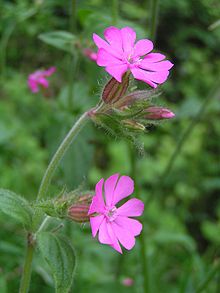- Silene dioica
-
Red Campion 
Silene dioica (Red Campion) Scientific classification Kingdom: Plantae (unranked): Angiosperms (unranked): Eudicots (unranked): Core eudicots Order: Caryophyllales Family: Caryophyllaceae Genus: Silene Species: S. dioica Binomial name Silene dioica
(L.) Clairv.Red campion (Silene dioica, syn. Melandrium rubrum) is a flowering plant in the family Caryophyllaceae, native throughout central, western and northern Europe, and locally in southern Europe.
It is a herbaceous biennial or perennial plant, with dark pink to red flowers, each 1.8-2.5 cm across. The flowers are unscented. There are five petals which are deeply notched at the end, narrowed at the base and all go into an urn-shaped calyx. It flowers from May to October. The plant grows to 30-90 cm, with branching stems. The deep green leaves are in opposite pairs, simple acute ovate, 3-8 cm long with an untoothed margin; both the leaves and stems of the plant are hairy and slightly sticky. The upper leaves are stalkless. Male and female flowers are born on separate plants, the male with 10 stamens and a 10-veined calyx, the female with 5 styles and a 20-veined calyx. The fruit, produced from July onwards, is an ovoid capsule containing numerous seeds, opening at the apex by 10 teeth which curve back.
Red campion grows in roadsides, woodlands, and rocky slopes. It prefers to grow on damp, non-acid soils.[1]
Plants with paler pink flowers are hybrids with the closely related White Campion (S. latifolia); these are common in some areas.
Distribution
Silene dioica is native and locally abundant through the British Isles.[2] It is generally common in Northern Ireland,[3] but rare elsewhere in Ireland.[4]
Uses
Besides the aesthetic value of its flowers, the crushed seeds of red campion have also been used to cure snakebites . The nectar of the flowers is utilised by bumblebees and butterflies, and several species of moth feed on the foliage.[5]
References
- ^ EnchantedForest: Red Campion
- ^ Clapham, A.R., Tutin, T.G. and Wsarburg, E.F. 1962. Flora of the British Isles. Cambridge University Press.
- ^ Hackney, P.(Ed) 1992. Stewart & Corry's Flora of the North-east of Ireland. Third Edition Institute of Irish Studies, The Queen's University of Belfast. ISBN 0 85389 446 0
- ^ Webb, D.A., Parnell, J. and Doogue, D. 1998. An Irish Flora. Seventh Revised Edition. Dundalgan Press (W. Tempest) Ltd. Dundalk. ISBN 0 85221 131 7
- ^ Englishplants: Red Campion
Categories:- Silene
- Caryophyllales stubs
Wikimedia Foundation. 2010.
